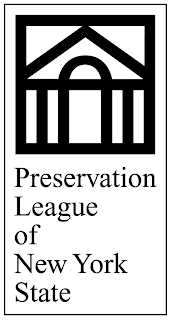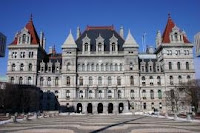The New York State Board for Historic Preservation recommended that 24 properties be added to the State and National Registers of Historic Places, including the nationally significant Haviland Middle School in Hyde Park and the birthplace of an important American statesman, William H. Seward.
State and National Historic Register listing can assist property owners in revitalizing the structures, making them eligible for various public preservation programs and services, such as matching state grants and state and federal historic rehabilitation tax credits. Listing will oblige state and federal government agencies whose projects would adversely impact the properties to consider other options. Private projects are not subject to state or federal review after a property is listed, and private property owners – or in historic districts, a majority of property owners – must consent for the listing to move forward.
The State and National Registers are the official lists of buildings, structures, districts, landscapes, objects and sites significant in the history, architecture, archeology and culture of New York State and the nation. There are approximately 90,000 historic buildings, structures and sites throughout the state listed on the National Register of Historic Places, individually or as components of historic districts. Property owners, municipalities and organizations from communities throughout the state sponsored the nominations.
Once the recommendations are approved by the state historic preservation officer, the properties are listed on the New York State Register of Historic Places and then nominated to the National Register of Historic Places, where they are reviewed and, once approved, entered on the National Register.
STATE REVIEW BOARD RECOMMENDATIONS
Dutchess County
Franklin Delano Roosevelt High School, Hyde Park. – today the Haviland Middle School, the architecturally and historically significant Colonial Revival-style school shares direct associations with President Franklin Delano Roosevelt, who, along with First Lady Eleanor Roosevelt, dedicated the building at a public ceremony in October 1940, and made several subsequent appearances there.
Erie County
The Calumet, Buffalo – the 1906 commercial building is unique example of the use of glazed architectural terra cotta, decorated with running reeds, their leaves and flowers.
The Zink Block, Buffalo – the 1896 commercial building with Italian Renaissance styling is a particularly rare resource on the once thriving Connecticut Street commercial corridor, which before the mid-century stood as a thriving commercial anchor for the neighborhood.
Kensington Gardens Apartment Complex, Buffalo – the apartment complex built for the influx of workers to the city’s World War II industries reflects designs of the Garden City movement and was one of the earliest projects supported by the Federal Housing Administration.
Nassau County
Glen Cove Post Office, Glen Cove – the distinctive Craftsman/Tudor-style structure was built in 1905 to serve the community’s fast-growing population.
Johns S. Phipps Estate, Old Westbury – the National Register of Historic Places listing from 1976 will be amended to include a large part of the property known as Orchard Hill, which was part of the original estate, and the more information on the significance of the estate’s landscaping and architecture.
Onondaga County
John G. Ayling House, Syracuse – the 1915 Tudor Revival home was designed by noted Syracuse architect Ward Wellington Ward.
Indian Castle Village Site, Manlius and Carley Onondaga Village Site, Pompey – the two sites are significant in the history of the Onondaga Nation and the regional development of the Iroquois Confederation and have yielded significant archaeological insight into domestic life in the seventeenth century.
Orange County
John G. Beakes House, Middletown – built around 1884, the Queen Anne-style home is an architecturally significant example of fashionable middle class housing erected at a time when the city’s West Main Street was being developed as a desirable residential quarter.
Grace Episcopal Church, Middletown – a prominent and recognizable landmark built in 1846 and substantially modified in the late 1860s, Grace Episcopal Church’s soaring spire and highly picturesque masonry work mark it as a significant example of 19th century Gothic Revival-style religious architecture.
Mortimer Mapes House/William H. Seward Birthplace, Florida – the property includes an 1887 Queen Anne-style home built for a prominent local citizen as well as the 1797 home – later converted into a carriage house – where New York Governor, U.S. Senator and U.S. Secretary of State William H. Seward was born.
Queens County
Saint Luke’s Episcopal Church, Forest Hills – the church and parish hall complex built in stages between 1924 and 1950 is an outstanding example of early-20 century Collegiate Gothic architecture.
Richmond County
Louis A. and Laura Stim House/Casa Belvedere, Staten Island – the 1908 Renaissance mansion, a prominent reminder of the 19th and early 20th-century development of Grymes Hill as a fashionable enclave of great estates and overlooking New York Harbor, is one of the few houses of its kind surviving on Staten Island.
Saratoga County
Nathan Garnsey House, Rexford – built in 1791 and remaining in the same family for generations, the home is a virtually untouched gem of Federal architecture owned by one of Clifton Park’s important first families
Jonesville Store, Jonesville – originally built about 1845 or 1850, and expanded in 1900, the Main Street building has been a community gathering spot since throughout its history.
Mohawk Valley Grange Hall, Clifton Park – the 1896 single-story wood frame building used as a gathering place for the agricultural community retains its rural setting, despite the town’s increasing suburbanization.
Abraham Best House, Vischer Ferry – built around 1815, the sophisticated brick federal farmhouse is a rare survivor from the agricultural era of Clifton Park.
Cyrus Rexford House, Rexford – the Stick-style Victorian was built in 1883 by Cyrus Rexford, who owned a canal store in the hamlet named for his father, and served as Clifton Park town supervisor and justice of the peace.
Suffolk County
Winganhauppauge, Islip – the 1941 French Provincial style home was built for Dr. Richard Pasternack, a research scientist whose work allowed Pfizer, his employer, to become the largest producer and distributor of pharmaceuticals in the world in the twentieth century.
The Edwards Homestead, Sayville – believed to be the oldest extant residence in Sayville with a portion dating to 1785, the home is an excellent surviving example of an early Long Island farmstead that began as a smaller New England Colonial but expanded over time by the family of early colonial settlers.
Sullivan County
Greenville Preparative Meeting House/Catskill Meeting House, Grahamsville – built in 1838-39 by Quakers from New England and the Hudson Valley, the simple and symmetrical building remains virtually unchanged since its original construction, lacking central heat, electricity, and indoor plumbing.
Washington County
L.C. Simonds Adirondack Cabin, Clemons – the 1910 cabin built by a Whitehall manufacturer features the hallmarks of the so-called Adirondack style, popularized in the late 19th century, including saddle-no
tched spruce log walls, rustic rough hewn masonry chimney, wraparound porch, and interior rustic detailing.
Westchester County
Hartsdale Railroad Station, Hartsdale – built in 1914 to replace and earlier, smaller wood frame structure, the Tudor Revival-style structure has a pivotal role in the connecting Hartsdale to New York City and attracting homeowners to the community.






